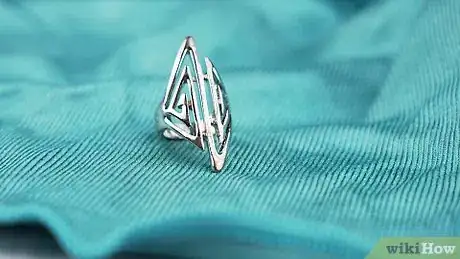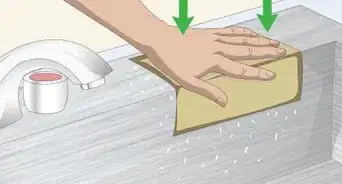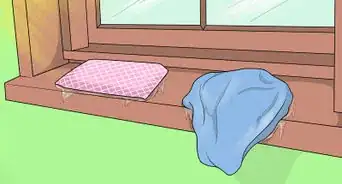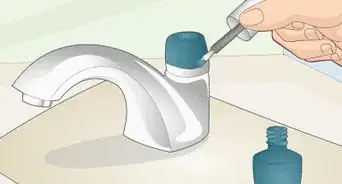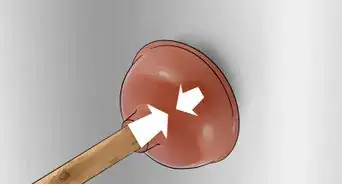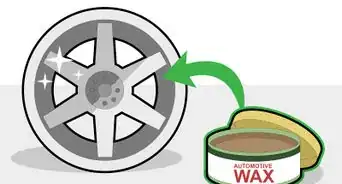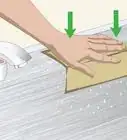This article was co-authored by Raymond Chiu. Raymond Chiu is the Director of Operations for MaidSailors.com, a residential and commercial cleaning service based in New York City that provides home and office cleaning services at affordable prices. He has a Bachelors in Business Administration and Management from Baruch College.
This article has been viewed 745,951 times.
Stainless steel is one of the most resilient materials available for a wide range of household and industrial uses. Its chromium film is responsible for its resistance to rust and tarnish, and with proper care, this film can provide protection for many years. The integrity of the film can be damaged by dirt and other contaminants however, so stainless steel must be cleaned regularly with safe cleaning products. Some mild detergents and a little bit of elbow grease should keep your stainless steel shining for years to come.
Steps
Cleaning Stainless Steel Pans
-
1Clean your pan after normal usage. For general cleaning, dirty pans can be cleaned with dishwashing soap and water in the sink. Pans should be washed by hand, because dishwashers can work away at the handles of your pans.
- Use a towel or rag to immediately dry your pan. This immediate drying helps prevent water spots. If water spots do form, rinse them in club soda (reused from pan to pan) and dry with a soft rag or cloth.
-
2Clean stuck-on food. Fill your pan with about 1 inch of water and put it on a stove burner. Turn the stove on, and wait for the water to boil.
- Once the water is boiling, add 2 tablespoons of salt, or 1 tablespoon of baking soda.
- Put the stove flame on low/medium low, and let this mixture lightly boil for approximately 30 minutes.
Advertisement -
3Scrape off residue. Use a plastic or wooden spatula to rub the bottom of the pan, lifting off the stuck food. Continue scraping the bottom of the pan until all the stuck-on food is removed.
- If your pan only has burn marks, you can sprinkle baking soda onto the burnt areas and scrub them away with a soft sponge. The baking soda will help dissolve the burn marks.
- You can add the baking soda to a dry pan, or mix it with a small amount of water to make a baking soda paste. After you have removed the burn marks, rinse the pan with clean water and dry it with a clean cloth.
- For really tough burn marks, but you can use a slightly abrasive sponge to scrub and lift away the burned areas.
-
4Polish your pans. After you clean your pans, give them some luster by using a cookware polish designed especially for stainless steel. You can find stainless steel cookware polish at most hardware stores and grocery stores around kitchen appliance aisles and areas.
- Be sure not to use industrial strength stainless steel polish on your pans. Industrial stainless steel polish has much harsher cleaning chemicals than cookware stainless steel polish.
Cleaning Stainless Steel Appliances and Cutlery
-
1Remove surface grime. Scrub off any pieces of food, grease, and fingerprints from your appliance surface. A wet towel and a mild detergent like dish soap, work well for the initial cleaning of the stainless steel appliances. Only use a few drops of the mild detergent so it doesn’t leave behind a soapy residue while cleaning.
- If there is dried, stuck-on food, you can try using a nylon scrubbing pad to loosen the food.[1]
- Do not use steel wool scrubbers of any other kind of cleaning utensil that is not labeled “non-scratch.” Using harsh, abrasive cleaning tools could create costly scratches in the stainless steel surface. This damage may require the repair assistance of a professional.[2]
-
2Polish your appliance. Stainless steel can be polished with common, household products like glass cleaner, olive oil, lemon oil, and baby oil.[3] Slightly moisten a rag or a microfiber cloth with your chosen polishing product (a little product goes a long way), and thoroughly wipe the stainless steel surface.
- Follow the grain of the appliance while polishing. That way, you reduce the risk of making scratches in the stainless steel surface.
-
3Buff off the excess polish. Use the dry side of the cloth to buff and wipe away any remaining polishing solution. In the end, you want your appliance surface to be dry to the touch.
- If your appliance still has streaks after you polish it, consider getting a stainless steel cleaner from a hardware store.
Cleaning Stainless Steel Sinks
-
1Apply your non-abrasive cleaning product. Sprinkle and evenly distribute about 2 tablespoons of baking soda onto the dry sink’s surface. Use a damp sponge to rub and spread the baking soda around the sink’s basin surface.[4]
- You may want to use harsh cleansers to remove the stains in your sink basin, but resist the temptation.[5] Using bleach and other aggressive chemical cleansers can actually do more harm than good.
EXPERT TIPRaymond Chiu is the Director of Operations for MaidSailors.com, a residential and commercial cleaning service based in New York City that provides home and office cleaning services at affordable prices. He has a Bachelors in Business Administration and Management from Baruch College.House Cleaning Professional
 Raymond Chiu
Raymond Chiu
House Cleaning ProfessionalOur Expert Agrees: You can clean heavy stains with a mixture of baking soda and warm water. If it's general cleaning, use a microfiber cloth with warm water and a couple of drops of dish soap. Wipe the stainless steel in the direction of the grain and towel dry to avoid streaks. For added shine, wipe on baby oil with a microfiber cloth.
-
2Pour vinegar on the sink's surface. The vinegar will react with the baking soda and start to foam. This foaming will help lift off the stain on the sink’s stainless steel surface. Leave the vinegar for about 10 minutes to ensure the baking soda and vinegar mixture thoroughly loosen the surface impurities.[6]
- To evenly coat the sides of the sink, consider adding the vinegar to a spray bottle and spraying all around the basin. This will allow for a controlled coating of vinegar, rather than pouring vinegar down the sides of the sink.
- Using a soft bristled toothbrush can help clean the smaller, hard to reach areas of the sink, like the drain and grooves around the drain.
-
3Rinse the sink. Rinse out the sink basin with water, and wipe it dry with a towel or cleaning cloth. Your sink should be shiny and clean, ready for the next use.
- Consider protecting your sink basin with a plastic or rubber mat. Sink mats are cheap, and can help prevent damage from sharp silverware and dishes.[7]
- If you do use a mat, detach the mat from the sink at least once a week to give both the sink and mat a thorough cleaning. This will help prevent food debris and bacteria from accumulating on the mat and sink surfaces.
Cleaning Stainless Steel Jewelry
-
1Fill a small bowl with water. Add some mild detergent, like dish soap, to the water. Dip a clean cloth into the water and soap mixture, and wring out the cloth. Then, wipe the piece of jewelry with the cloth until the jewelry is clean.
- Wipe and clean the jewelry going along the grain of the piece. This helps maintain the jewelry’s uniform finish.
-
2Clean with toothpaste. Consider using toothpaste to clean your jewelry if it is especially dirty and has some specific soiled areas. However, remember that toothpaste is slightly abrasive and could possible damage the jewelry piece. Rinse the jewelry thoroughly with water once your are finished cleaning it with the toothpaste.
- If you decide to use toothpaste to clean your jewelry, use a cloth to rub the toothpaste onto the jewelry surface. Also make sure the toothpaste is a non-whitening brand that doesn’t contain silica. The whitening products and the silica can damage the stainless steel finish.[8]
-
3Dry the jewelry. Use a clean cloth to wipe down the piece of jewelry, and then leave it to air dry completely.
-
4Store your jewelry properly. Although stainless steel is durable, it can scratch. Try to store your jewelry away from other jewelry items that can potentially damage and scratch the stainless steel.[9]
- A professional jeweler can also polish and repair damaged jewelry.
- It’s best to store your stainless steel pieces separately from jewelry made of other metals. Consider keeping stainless steel jewelry in individual pouches.[10]
Community Q&A
Did you know you can get answers researched by wikiHow Staff?
Unlock staff-researched answers by supporting wikiHow
-
QuestionWhat can stain stainless steel?
 wikiHow Staff EditorThis answer was written by one of our trained team of researchers who validated it for accuracy and comprehensiveness.
wikiHow Staff EditorThis answer was written by one of our trained team of researchers who validated it for accuracy and comprehensiveness.
Staff Answer wikiHow Staff EditorStaff Answer
wikiHow Staff EditorStaff Answer -
QuestionWhy do I have to rub on the grain?
 wikiHow Staff EditorThis answer was written by one of our trained team of researchers who validated it for accuracy and comprehensiveness.
wikiHow Staff EditorThis answer was written by one of our trained team of researchers who validated it for accuracy and comprehensiveness.
Staff Answer wikiHow Staff EditorStaff Answer
wikiHow Staff EditorStaff Answer -
QuestionCan I use bleach on stainless steel?
 wikiHow Staff EditorThis answer was written by one of our trained team of researchers who validated it for accuracy and comprehensiveness.
wikiHow Staff EditorThis answer was written by one of our trained team of researchers who validated it for accuracy and comprehensiveness.
Staff Answer wikiHow Staff EditorStaff Answer
wikiHow Staff EditorStaff Answer
Warnings
- Nitric acid is a highly corrosive chemical and should not be used if you are not familiar with proper handling and disposal techniques.⧼thumbs_response⧽
- Do not apply bleach to stainless steel. Stainless is sensitive to chlorine, and contact with bleach will result in staining and damage to the protective film.⧼thumbs_response⧽
- Be careful when mixing any types of cleaners. Don't mix commercial cleaners, such as "Bar Keepers Friend," with vinegar or with other brands.⧼thumbs_response⧽
Things You'll Need
- Warm water
- Soft cloths or sponges
- Mild detergent
- Vinegar
- Baking soda
- Toothpaste
- Toothbrush
- Glass cleaner/olive oil/lemon oil/baby oil
- Plastic/rubber sink mat
References
- ↑ http://www.quickanddirtytips.com/house-home/housekeeping/how-to-clean-stainless-steel
- ↑ http://www.quickanddirtytips.com/house-home/housekeeping/how-to-clean-stainless-steel
- ↑ http://www.quickanddirtytips.com/house-home/housekeeping/how-to-clean-stainless-steel?page=1
- ↑ http://www.quickanddirtytips.com/house-home/housekeeping/how-to-clean-stainless-steel?page=1
- ↑ http://www.quickanddirtytips.com/house-home/housekeeping/how-to-clean-stainless-steel?page=1
- ↑ http://www.quickanddirtytips.com/house-home/housekeeping/how-to-clean-stainless-steel?page=1
- ↑ http://www.quickanddirtytips.com/house-home/housekeeping/how-to-clean-stainless-steel?page=1
- ↑ http://www.jewelrynotes.com/how-to-care-for-stainless-steel-jewelry/
- ↑ http://www.jewelrynotes.com/how-to-care-for-stainless-steel-jewelry/
About This Article
To clean stainless steel appliances, scrub off fingerprints and food with a wet towel and a few drops of dish soap, then polish with a bit of olive oil or glass cleaner. To clean a stainless steel sink, sprinkle 2 tbsp (12 g) of baking soda and some vinegar onto the dry sink, let sit for 10 minutes, then rinse and wipe dry. Wash stainless steel pots by hand with dish soap and water. To clean stainless steel jewelry, soak a cloth with water and dish soap and wipe it along the grain of your piece. If you want to learn how to polish the stainless steel once it's clean, keep reading!




